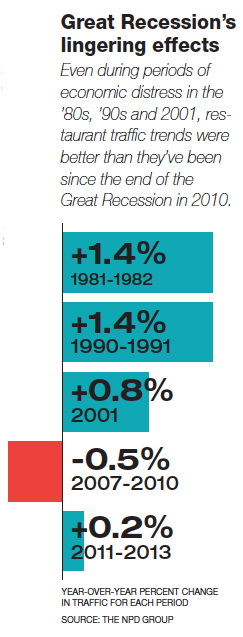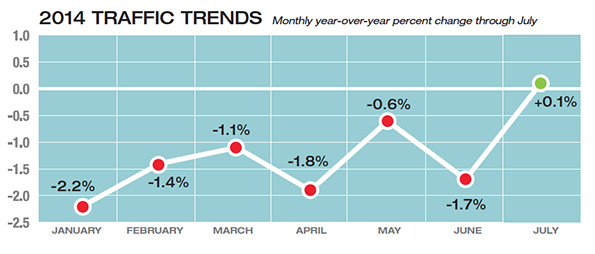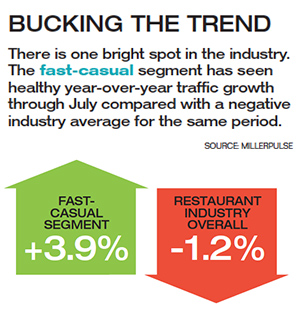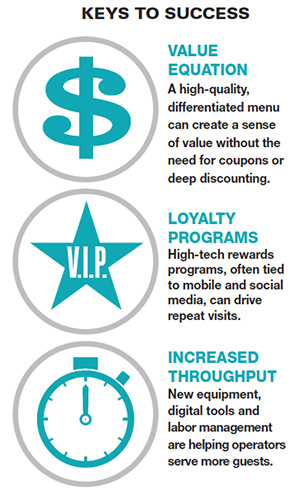“We’ve never experienced anything like this before.” — Bonnie Riggs, restaurant analyst at market research firm The NPD Group
Since 2008, the weakened economic environment has been described as “the new normal.” Change is ever present, companies need to move quickly to succeed, and shifting consumer demands have created a path of uneven terrain for operators.
One factor has remained consistent for many in the foodservice industry: Declining traffic.
While dips in guest counts and sales are to be expected during economic recessions and slow recoveries, this time it’s different. Since the recession, the number of people walking through the doors of restaurants has remained negative or flat at best. In 2013, consumers made about 61 billion visits to restaurants, down 1.3 billion visits since the pre-recession days of 2007. That number is expected to grow only modestly over the next eight years to about 63.5 billion, with traffic growth increasing an average of no more than 0.5 percent per year, according to The NPD Group, the industry’s leading tracker of restaurant traffic.
Since the recession, the number of people walking through the doors of restaurants has remained negative or flat at best. In 2013, consumers made about 61 billion visits to restaurants, down 1.3 billion visits since the pre-recession days of 2007. That number is expected to grow only modestly over the next eight years to about 63.5 billion, with traffic growth increasing an average of no more than 0.5 percent per year, according to The NPD Group, the industry’s leading tracker of restaurant traffic.
The fine-dining segment, which is a relatively small piece of the industry, has seen some traffic growth — up 6 percent in 2013 — with the return of business travel and expense account-driven dining. In direct contrast, the casual-dining and limited-service segments have struggled to see increased guest counts or transactions in recent years.
According to NPD, year-over-year guest traffic results in 2013 were flat for the quick-service segment, fell 1 percent for casual dining and declined 2 percent for what NPD refers to as the midscale-casual chains, which include family-dining brands.
Even worse, restaurant operators looking for change will be searching for some time.
Black Box Intelligence, a leading provider of restaurant industry sales data operated by TDn2K in Dallas, is projecting comparable traffic will decrease 1.9 percent industrywide for fiscal 2014. That will be the sixth consecutive year of negative trends.
“We coined the phrase that we kind of live in a 1-percent world,” said Wally Doolin, founder and CEO of the benchmarking firm. “Comp sales are up or down 1 percent. Even great companies that are doing a great job will probably just get traffic up a little.”

Why so different now?
Guest traffic declines at restaurants are not unusual during a recession, as consumers keep a tighter grip on their wallets. In the past, however, recessionary periods have always been followed by mini booms of recovery in spending.
Not so today.
Despite economic indicators pointing to job growth, higher pay rates, and improving consumer confidence, restaurants are not seeing that translate to an increase in dining out. “Even though they said the recession was over in 2010, many consumers never bought into that,” NPD Group’s Riggs said.
There are a number of factors to blame, she added, but the primary culprit has been the largely uneven recovery for American consumers. Upper-income families have resumed their dining-out habits, but Middle America remains squeezed economically, with little in the way of discretionary income for a night out at their favorite casual dining chain.
In addition, people have gotten used to cooking at home, she noted.
American consumers bought an average of 16 meals away from home per month in 2013, or 193 for the year. That’s down from a decade ago, when consumers were eating out an average of 18 meals per month, according to NPD.
Retail outlets, like grocery and convenience stores, have stepped up and improved their takeout options and become significant competitors for restaurant chains.
So now what?
(Continued from page 1)
The traffic challenge has left restaurant operators battling for market share and looking for new ways to get the attention of both new and existing guests.
Many chains are rushing to offer mobile ordering and payment or tap tabletop technologies in an attempt to draw in time-starved guests and those seeking convenience. Others are focusing on menu innovation, adding both craveable and more healthful options, as well as pushing catering and delivery to reach customers wherever they are. Whatever the approach, the ever-present challenge is to appeal to Millennials, who have been dining out less, leaving Baby Boomers to prop up industry trends, Riggs said.
Whatever the approach, the ever-present challenge is to appeal to Millennials, who have been dining out less, leaving Baby Boomers to prop up industry trends, Riggs said.
“Until we see Millennials in a better situation, we won’t see much growth in the industry,” she said. “We need that very large, younger group increasing their visits.”
Is anyone winning?
No segment has done that better than those in the fast-casual realm. Brands that can steal from that playbook will win, whether with higher-quality menu items, modern design and decor or heightened elements of service.
According to the monthly NRN-MillerPulse report, which collects industry data on indicators like traffic, the fast-casual segment has maintained positive traffic counts since the end of 2012. Larry Miller, MillerPulse’s chief executive, said much of those gains come from stealing traffic from both casual dining and quick service. Industrywide, MillerPulse’s traffic surveys indicate fits and starts. Some months drift positive, but then numbers drop again.
“We’ve been on both sides of zero and never really recover,” said Miller. “If you look at past recessions, there’s always a recovery in spending. We just haven’t had that.”
Miller contends that the frustration restaurant chains feel about their inability to meaningfully drive traffic is partly self-inflicted.
With commodity pressures threatening their margins, restaurant operators have been increasing menu prices. The result has been higher average checks and even positive same-store sales for some chains, but not because more guests are coming through the door.
“Restaurants have been pulling the price lever, and consumers noticed,” he said. “You always have to take some price, but the million dollar question is: ‘Is it too much?’ … I would hold the line on price right now as much as I could.”
Chipotle Mexican Grill and Starbucks are among chains that have increased prices this year, and both have demonstrated industry-busting increases in traffic.
Chipotle wowed the fast-casual world with a 12.3-percent increase in guest counts in its June 30-ended second quarter, and Starbucks’ transactions in the Americas region were up 2 percent.
McDonald’s Corp.’s second quarter ended with a 1.5-percent domestic same-store sales decline, which was blamed on traffic dips despite a higher average check. August was worse, with same-store sales in the U.S. down 2.8 percent, leaving some industry observers wondering if the burger giant has begun to lose its relevance.
What are the strategies for success?
(Continued from page 2)
It’s been a buzz word for years, but the notion of value is not going away. The value equation is still a critical factor for consumers.
Taco Bell, for example, recently launched a new Dollar Cravings menu with 11 items, each priced at $1. Chris Brandt, Taco Bell’s chief marketing officer, said the move was a response to consumers who complained that the craveable items they loved weren’t on the value menu.
Chris Brandt, Taco Bell’s chief marketing officer, said the move was a response to consumers who complained that the craveable items they loved weren’t on the value menu.
“Consumers get the joke” about dollar menus designed to attract customers with lower prices and then they get the upsell to higher-ticket items, said Brandt.
In response, Taco Bell created a lineup of products that the chain hopes will appeal to its key 18- to 34-year-old demographic in ways that satisfy various consumer “need states” and dayparts, from breakfast to afternoon snacks to late-night meals.
“We think these items will have appeal all day long,” said Brandt. “When you can provide what they want at a great price, people will beat a path to your door.”
Red Robin Gourmet Burgers is also talking value again after traffic dipped 2.5 percent in its second quarter, the first time in eight quarters the chain performed below its peers.
Company officials blamed marketing missteps, including a shift in message away from everyday-value-positioned menu items like the Tavern Double platform, with burgers starting at $6.99 with options for $1 add-ons.
Steve Carley, Red Robin’s chief executive, said the chain will return to its everyday-value theme.
“We have no intention of following the aggressive discounting of our peers, but rather seek to find a delicate balance of driving profitable traffic by differentiating ourselves through sustained everyday value, new menu innovation, our burger barbell strategy and superior Red Robin service,” Carley said.
At the same time, restaurant chains have been brainstorming how they can effectively market themselves as offering something new and different — without freebies or discount promotions. Loyalty programs, especially those tied to mobile or social media, are a growing tool and offer key marketing insights.
In a recent report, NPD concluded that loyalty is closely tied to convenience in generating repeat visits. Four out of 10 diners say they may visit certain restaurants repeatedly because it “meets their needs of the moment.”
Other chains are working hard on their throughput, trying to move customers through the line faster or speed service.
Panera Bread Co. has been working on its throughput with various initiatives, including new kitchen display systems, upgraded equipment, and new technologies to manage labor and inventory. By the end of the year, the 1,800-unit chain expects to have mobile and online ordering in place with its Rapid Pick-Up system.
Contact Lisa Jennings at [email protected].
Follow her on Twitter: @livetodineout





